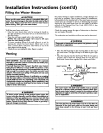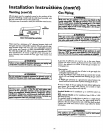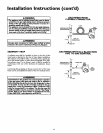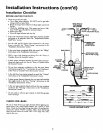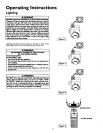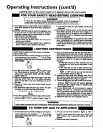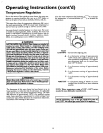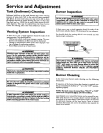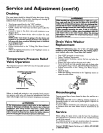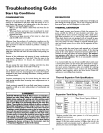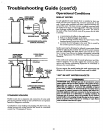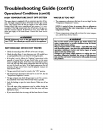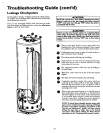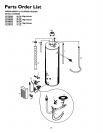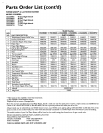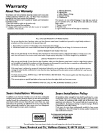
Troubleshooting Guide
Start Up Conditions
CONDENSATION SMOKE/ODOR
Whenever the water heater is filled with cold water, a certain
amount of condensation will form while the burner is on. A
water heater may appear to be leakingwhen in fact the water is
condensation. This usually happens when:
• When a new water heater is filled with cold water for the
first time.
• When gas burns and water vapor isproduced in water
heaters, particularly high efficiency models where flue tem-
peratures are lower.
• When you use large amounts of hot water in a short time
and the refill water is very cold.
Moisture from the products of combustion condense on the
cooler tank surfaces and form drops of water which may fall
onto the burner or other hot surfaces to produce a "sizzling" or
"frying" noise.
Excessive condensation can cause pilot outage due to water run-
ning down the flue tube onto the main burner and putting out
the pilot.
Because of the suddenness and amount of water, condensation
water may be diagnosed as a "tank leak". After the water in the
tank warms up (about 1-2 hours), the condition should
disappear.
Do not assume the water heater is leaking until there has been
enough time for the water in the tank to warm up.
An undersized water heater will cause more condensation. The
water heater must be sized properly to meet the family's
demands for hot water including dishwashers, washing machines
and shower heads.
Excessive condensation may be noticed during the winter and
early spring months when incoming water temperatures are at
their lowest.
Good venting is essential for a gas fired water heater to operate
properly as well as to carry away products of combustion and
water vapor.
It is not uncommon to experience a small amount of smoke and
odor during the initial start-up. This is due to burning off of oil
from metal parts, and will disappear in a short while.
THERMAL EXPANSION
Water supply systems may, because of high line pressure, fre-
quent cut-offs, the effects of water hammer and others, have
installed devices such as pressure reducing valves, check valves,
back flow preventers, etc. to control these types of problems.
When these devices are not equipped with an internal by-pass,
and no other measures are taken, the devices cause the water sys-
tem to be closed. As water is heated, it expands (thermal expan-
sion) and closed systems do not allow for the expansion of heat-
ed water.
The water within the water heater tank expands as it is heated
and increases the pressure of the water system. If the relieving
point of the water heater's temperature-pressure relief valve is
reached, the valve will relieve the excess pressure. The tempera-
ture-pressure relief valve is not intended for the constant
relief of thermal expansion. This is an unacceptable condition
and must be corrected.
It is recommended that any devices installed which could create
a closed system have a by-pass and/or the system have an expan-
sion tank to relieve the pressure built by thermal expansion in
the water system. Expansion tanks are available for ordering
through the Sears Service Center. Contact the local plumbing
inspector, water supplier, and/or the Sears Service Center for
assistance in controlling these situations.
Thermal Expansion Tank Specifications
Model ITank Capacity Dimensions in Inches Pipe Fitting
Number I In Gallons Diameter Length On Tank
153.331020 2 8 inches 12_ inches _" Male
153.331050 I 5 llinches il4_inches! _"Male
_E,WARNING
HOTTER WATERCAN SCALD:Water heaters are intendedto
pr_..ucehot water,Water heatedto a temperaturewhichwill
satisfydotheswashing,dishwashing,andothersanitizingneeds
canscaldandpermanentlyinjureyouuponcontact.Somepeo-
plearemore likelyto bepermanentlyinjuredbyhot waterthan
others.Theseincludetheelderly,children,the infirm,orphysical-
ly/mentellyhandicapped.Ifanyoneusinghotwaterin yourhome
fitsintooneofthusegroupsor ifthereisalocalcodeor statelaw
requiring acertaintemperaturewater atthe hotwatertap,than
foumusttakespecialprecautions.In additionto usingthelowest
3ossibletemperaturesettingthat sa_t'msyourhot waterneeds,
i meanssuchasa mixingvalve,shouldbe usedat the hotwater
tapsusedbythese peopleor at the waterheater,Mixingvalves
areavailableat plumbingsupplyor hardwarestores.Followman-
ufacturersinstructionsfor installationof the valves.Before
changingthe factory setting on the thermostat, read the
"Temperature Regulation"sectioninthis manual.
Expansion Tank Sizing Chart
Expansion
Tank
Capacity
Needed
Inlet* Water Heater Capacity (Gallons)
Water
Pressure 30 40 ! 50 ' 66 82
40psi I 2 ; 2 2 i 5 5- -
4 I i --
50psi 2 1 2 , 2 _ 5 | 5
60psi- -I-2 i 2 -! 5_-:---5-_
70psi [ 2 ! 2 i 5 5 , 5
!80psi 2 5 5 ' 5 ] 5
*Highest recorded inlet water pressure in a 24 hour period or
regulated water pressure.
NOTE: Expansion tanks are pre-charged with a 40 psi air
charge. If the inlet water pressure is higher than 40 psi, the
expansion tanks air pressure must be adjusted to match that
pressure, but must not be higher than 80 psi.
22



